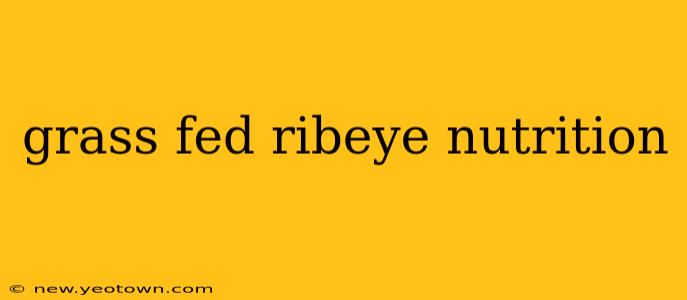The sizzle of a perfectly seared ribeye, the rich aroma filling the air... Ah, the culinary delight! But beyond the sensory pleasure lies a nutritional powerhouse, especially when that ribeye comes from grass-fed cattle. Let's delve into the nutritional profile of this delectable cut of meat and explore why it's considered a premium choice.
Our story begins on lush pastures, where cattle graze freely, their diets consisting of nutrient-rich grasses and herbs. This natural feeding method significantly impacts the nutritional composition of the resulting ribeye steak compared to its grain-fed counterpart.
Grass-Fed vs. Grain-Fed: What's the Difference?
The most significant difference lies in the fat profile. Grass-fed ribeyes boast a higher concentration of beneficial fats, including omega-3 fatty acids and conjugated linoleic acid (CLA). These fats are associated with numerous health benefits, from improved heart health to reduced inflammation. Grain-fed ribeyes, on the other hand, tend to have a higher proportion of saturated fats.
This difference in fat content also influences the overall flavor and texture. Grass-fed ribeyes often possess a leaner profile with a more intense, complex flavor, while grain-fed versions can be richer and more marbled.
What are the Nutritional Benefits of Grass-Fed Ribeye?
A typical 3-ounce serving of grass-fed ribeye provides a significant amount of protein, essential for building and repairing tissues. It's also a good source of various vitamins and minerals, including:
- Vitamin B12: Crucial for nerve function and red blood cell formation.
- Iron: Essential for carrying oxygen throughout the body.
- Zinc: Supports immune function and wound healing.
- Selenium: A powerful antioxidant that protects cells from damage.
Is Grass-Fed Ribeye Higher in Cholesterol?
This is a common question. While grass-fed ribeye does contain cholesterol, the impact on blood cholesterol levels is complex and not fully understood. Recent research suggests that dietary cholesterol's effect on blood cholesterol is less significant than previously thought. However, individuals with high cholesterol should still consult with their healthcare provider about their dietary intake.
How Many Calories are in a Grass-Fed Ribeye?
The calorie count varies depending on the size and fat content of the steak. A 3-ounce serving generally contains between 200-300 calories. However, it's important to remember that portion size plays a crucial role in overall calorie intake.
Is Grass-Fed Ribeye Better for You Than Grain-Fed?
The nutritional advantages of grass-fed ribeye are compelling. The higher levels of omega-3 fatty acids, CLA, and other beneficial nutrients make it a healthier choice compared to grain-fed alternatives. However, both types of ribeye can be part of a balanced diet, and the best choice depends on individual dietary preferences and health goals.
What are the Potential Downsides of Grass-Fed Ribeye?
While generally considered healthier, grass-fed ribeye can be more expensive than grain-fed options. It can also be tougher in texture if not cooked properly. Proper cooking methods, such as reverse searing, can help tenderize the meat and maximize its flavor.
Conclusion: Savoring the Nutritional Riches
Grass-fed ribeye offers a unique blend of flavor, texture, and nutritional benefits. Its higher concentration of healthy fats, vitamins, and minerals makes it a premium choice for health-conscious consumers. By understanding its nutritional profile and incorporating it mindfully into a balanced diet, you can truly savor the richness of this exceptional cut of meat. Remember, moderation and variety are key to a healthy eating pattern.

